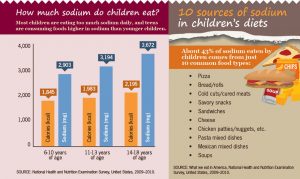Did you know that 9 in 10 US children (90%) eat more sodium than recommended? It’s true! And most of the sodium they consume comes from the salt in the processed foods they eat.
Ten common types of foods contributed more than 40% of the sodium eaten by children. Have you been serving high-sodum foods without even realizing it?
The taste for salt is established through diet at a young age. Parents and caregivers influence the way foods are produced, sold, prepared, and served – and are in the perfect position to help lower the sodium eaten by the children in their lives.
A high-sodium diet can lead to high blood pressure, or hypertension. High blood pressure is often called a silent killer, because it usually doesn’t cause symptoms while it is causing damage.
About 1 in 6 children ages 8-17 years has raised blood pressure. High blood pressure is a major risk factor for heart disease and stroke. Lowering sodium in children’s diets today can help prevent heart disease later in life, especially for those who are overweight.
About 25% of people with type 1 diabetes and 80% of people with type 2 diabetes have high blood pressure. Having diabetes raises your risk of heart disease, stroke, kidney disease and other health problems – and having high blood pressure also raises this risk.
What you can do as a parent or caregiver:
- Model healthy eating for your children by having a diet rich in fruits and vegetables without added sodium.
- Compare Nutrition Facts labels to choose the lowest sodium option before you buy.
- Ask your grocery manager to provide more low sodium options of your family’s favorite foods.
- Request restaurant nutrition information to make lower sodium choices.
How much sodium is too much for kids?
U.S. children (ages 6-18 years old) eat an average of about 3,300 mg of sodium a day BEFORE salt is added at the table. The 2010 Dietary Guidelines for Americans recommend that children eat less than 2,300 mg per day!
Eating too much sodium affects some people’s blood pressure more than others. Children in the following groups should eat even less sodium – with a limit of about 1,500 mg per day:
- African American Children
- Children with Hypertension
- Children with Diabetes
- Children with Chronic kidney disease
Teens consume more calories – and more sodium rich foods – than younger children.
Where the Salt is Coming From
Every meal and snack.
Children eat about 15% of sodium at breakfast, 30% at lunch, 39% at dinner, and 16% at snacks.
Common foods.
About 43% of sodium eaten by children comes from just 10 common food types:
- pizza
- bread and rolls
- cold cuts and cured meats
- sandwiches like cheeseburgers (make homemade burgers instead)
- snacks, such as chips
- cheese
- chicken patties, nuggets, and tenders
- pasta mixed dishes, such as spaghetti with sauce (make homemade tomato sauce instead)
- Mexican mixed dishes, such as burritos and tacos
- soup
Processed foods and restaurant foods.
Most sodium is already in food before you buy it or order it. About 65% comes from store foods, 13% from fast food and pizza restaurant foods, and 9% from school cafeteria foods.
Lets’s STOP Raising a Salty Generation of Kids…

Bar graph shows average daily calorie and sodium intake for children 6-11 (1,845 kcal and 2,903 mg of sodium), children 11-13 (1,983 kcal and 3,194 mg of sodium), and teens aged 14-18 (2,195 kcal and 3,672 mg of sodium).







